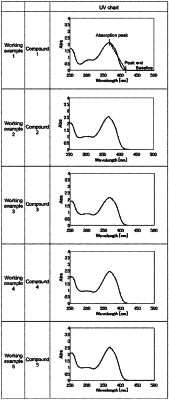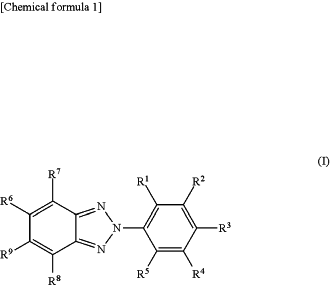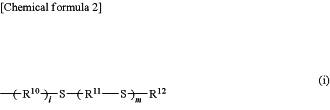| CPC C08K 5/3475 (2013.01) [B29C 48/022 (2019.02); C08L 25/06 (2013.01); C08L 33/10 (2013.01); B29K 2025/06 (2013.01); B29K 2033/12 (2013.01)] | 13 Claims |

|
1. A resin molding material for use in heat processing comprising: a 2-phenylbenzotriazole derivative that contains a thioether-containing group; and a resin, wherein the 2-phenylbenzotriazole derivative is represented by the following formula (I):
 wherein each of the R1 to R9 independently represents a monovalent or divalent group selected from a hydrogen atom, a hydrocarbon group, an aromatic group, an unsaturated group, a nitrogen-containing group, a sulfur-containing group, an oxygen-containing group, a phosphorus-containing group, an alicyclic group, a halogen atom and a thioether-containing group represented by the following formula (i) with the proviso that at least one of the R1 to R9 is a thioether-containing group represented by the following formula (i), and that any two of R1 to R9 together form a ring if they are divalent groups
 wherein in formula (i),
R10 represents a divalent hydrocarbon group having 1 to 20 carbon atoms in which hydrogen atoms may be substituted with, at least one of two ends may be interrupted by, or carbon-carbon bonds may be interrupted by a monovalent or divalent group selected from an aromatic group, an unsaturated group, a nitrogen-containing group, a sulfur-containing group, an oxygen-containing group, a phosphorus-containing group, an alicyclic group and a halogen atom;
R11 represents a divalent hydrocarbon group having 1 to 20 carbon atoms in which hydrogen atoms may be substituted with, at least one of two ends may be interrupted by, or carbon-carbon bonds may be interrupted by a monovalent or divalent group selected from an aromatic group, an unsaturated group, a nitrogen-containing group, a sulfur-containing group, an oxygen-containing group, a phosphorus-containing group, an alicyclic group and a halogen atom with the proviso that each of R11 is independently provided if m is not smaller than 2;
R12 is represented by the following formula (i):
[Chemical formula 3]
—((X)o—(Y)p—(Z)q)−H (j)
wherein X is a divalent aliphatic hydrocarbon group of which a hydrogen atom(s) may be substituted, Y is a divalent aromatic or alicyclic hydrocarbon group of which a hydrogen atom(s) may be substituted, Z is either a divalent heteroatom-containing group Z1 selected from a nitrogen-containing group, an oxygen-containing group, a sulfur-containing group and a phosphorus-containing group, or a divalent heteroatom Z2 selected from an oxygen atom and a sulfur atom;
wherein o, p and q are integers not smaller than 0; and
wherein X, Y and Z, respectively provided in the number of o, p and q, are independently provided, and the X, Y and Z may be in any sequential order; and
wherein at least one of the o and p is an integer of 1 or more; and
wherein l represents an integer of 0 or 1, and m represents an integer of 0 to 3.
|